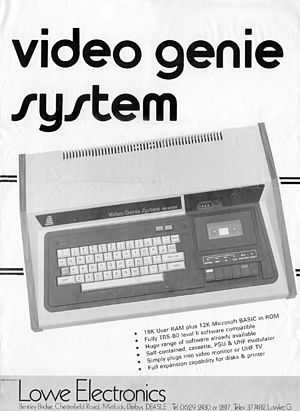Video Genie
- TRZ-80 redirects here. This should not be confused with the TRS-80 computer line.


Video Genie (or simply Genie) was a series of computers produced by Hong Kong-based manufacturer EACA during the early 1980s. They were compatible with the Tandy TRS-80 Model I computers and could be considered a clone, although there were hardware and software differences.
The computers making up the series were
- Video Genie System (EG3003 - first version, early/mid 1980)
- Video Genie System (EG3003 - second version, late 1980)
- Genie I (EG3003 - third version, late 1981)
- Genie II (EG3008 - late 1981)
- Genie III (EG3200 - mid 1982) - a more business-oriented machine with CP/M-compatibility.
Although Video Genie was the name used in Western Europe, the machines were sold under different names in other countries. In Australia and New Zealand they were known as the Dick Smith System 80 MK I (EG3003) and System 80 MK II (EG3008), and in North America they were sold as the PMC-80 and PMC-81. In South Africa the Video Genie was sold as the TRZ-80, a name similar to its rival.[2]
In early 1983, the related Colour Genie machine was released by EACA.

Features
- Video: Monochrome
- 64×16 / 32×16 uppercase text
- 128×48 block graphics
- Composite video output, cable included
- RF TV signal output, cable included
- 16 KB RAM, expandable to 48 KB
- 12 KB ROM containing Microsoft LEVEL II BASIC
- Storage: Built in 500 baud cassette deck
- Cable for using an external cassette deck included
- Built in powersupply
Versions
- The first version had only a 51-key keyboard and was missing the CLEAR and TAB keys as compared to the Tandy TRS-80 Model I.
- The second version had a corrected keyboard but sacrificed the right SHIFT key. This version also added a cassette-player VU-meter and volume control, a very helpful feature in loading software from cassettes.
- Genie I (the third version) featured inbuilt lowercase with drivers in the ROM extension. This ROM also contained an improved keyboard driver and a machine language monitor.
- Genie II was exactly like the Genie I but had a 19-key keypad instead of the internal cassette deck. Also the keyboard was updated, adding the missing right shift key, making the keyboard 53+19 keys. It was intended for use with floppy drives, although this still required the EG3014 Expander.
EG3014 Expander
The EG3014 Expander add-on corresponds to the Tandy TRS-80 Model I Expansion Interface. It has a Centronics printer port and a single density floppy interface for up to 4 single-sided or 3 double-sided drives. It also has sockets for adding two 16K banks of RAM (making it possible to expand to 48K RAM) and edge connectors for the EG3020 RS-232 interface and EG3022 S-100 bus interface. The EG3014 could also be expanded with the EG3021 double density kit.
EG3016 Parallel Printer Interface
Centronics printer port add-on.
EG3050 and EG3085 Printer
References and footnotes
- ↑ http://www.trs-80.org/pmc-80/
- ↑ Eric Lindsay, What's a TRZ-80? - or a Video Genie or a Dick Smith System 80?, 80 Microcomputing, January 1982, page 218
See also
References
External links
- "Video Genie System" at home.online.no
- "A Tribute to the Dick Smith System 80" at classic-computers.org.nz
- "System-80 ROMs" at theoldcomputer.com